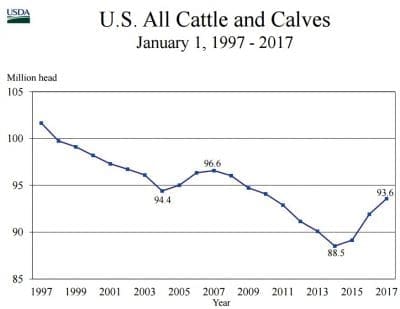THE US beef herd has continued to expand rapidly during the past 12 months, a January survey conducted by the US Department of Agriculture has shown.
USDA’s National Agriculture Statistics Service reported total US cattle numbers last month at 93.585 million head, a two percent rise on the same time last year (91.918m). The result was higher than pre-report estimates.
As the graph published below illustrates, the US herd is now at its highest level since 2010, and shows the nation’s beef industry is now well advanced in recovery from its two-year drought during 2012-13.
The US herd expansion has far-reaching implications for US beef importers, and external suppliers including Australia.

Source: USDA
“The steady increase in the beef cow herd and larger calf crops reduce the US reliance on imported beef, bolster overall US beef supplies and lower the long-run potential returns from sales into the US market,” Steiner Consulting reported last week.
The result is five million head larger than the US industry’s 2014 low-point in the cycle, and includes a breeding cow population currently estimated at 31.2m head, 3.5pc higher than a year ago. Pre-report estimates were expecting the beef cow herd to be up just 1.1pc from last year.
“While USDA made some downward revisions to its beef cow herd estimate for the previous year, current numbers suggest further gains in the 2017 calf crop and thus increasing domestic US beef supplies in 2018 and first half of 2019,” Steiner said.
“This is probably one of the more bearish numbers in the report, especially given speculation from some producers that US herd rebuilding has come to an end.”
In other key data to emerge from the USDA survey:
- US producers retained more heifers for beef cow replacement, increasing the national inventory by 79,000 head or +1.2pc. Beef cow replacement numbers hit a low of 5.1 million head in 2011 and have been increasing steadily since then. Current replacement numbers are the highest they have been since 1995.
- Feeder cattle supplies (cattle outside feedlots) as of January 1 were surveyed at 26.52 million head, 2.2pc higher than a year ago. Robust marketings during the last quarter of 2016 helped get feeder supplies more current, Steiner said. Cattle-on-feed inventories were down 1pc from the previous year, in line with the monthly USDA survey and also indicating that front-end US fed cattle supplies also are quite current. The report also showed a decline in the feedlot inventory in several states with a larger percentage of farmer-feeders. Last year these states showed a notable increase in feedlot cattle numbers but the sharp fed cattle price declines last northern hemisphere summer and autumn may have discouraged some producer-feeders.
“The bottom line is that US producers today have a larger production base (cows/ heifers) than they did last year,” Steiner said. “By holding back more heifers for replacement they also intend to continue to expand the production base this year, albeit at a smaller rate.”
“The larger production base implies continued increases in calf production and thus larger beef supplies in 2018 and 2019,” Steiner said.
